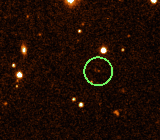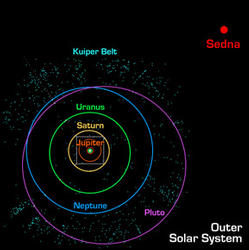Sedna
The Twelveth Planet
On 15 March 2004, astronomers from Caltech, Gemini Observatory, and Yale University announced the discovery of the coldest, most distant object known to orbit the sun. The object was found at a distance 90 times greater than that from the sun to the earth -- about 3 times further than Pluto, the most distant known planet.
The discovery was made on the Samuel Oschin Telescope at the Palomar Observatory east of San Diego on 14 November 2003 by the team of Mike Brown (Caltech), Chad Trujillo (Gemini Observatory) and David Rabinowitz (Yale).
Because of its frigid temperatures, the team has named the object Sedna, after the Inuit goddess of the sea from whom all sea creatures were created.
How far away is Sedna?
Sedna is the most distant solar system object ever discovered. It is twice as far from the sun as any other solar system object and three times farther than Pluto or Neptune. Standing on the surface of Sedna, you could block the entire sun with the head of a pin held at arm's length.
Even more interestingly, the orbit of Sedna is extreme elliptical, in contrast to all of the much closer planets, and it takes 10,500 years to circle the sun.
What is the Oort cloud and what is its relationship to Sedna?
The Oort cloud is a hypothetical shell of icy proto-comets in very loose orbits around the sun that extends to a distance of almost halfway to the nearest star. Occasionaly, passing stars cause a slight change in the orbit of one of these proto-comets which causes them to come steaking in to the inner solar system where we see them as comets. A nice explanation can be found here. Though the Oort cloud has never been seen directly, the comets that we do see are very strong evidence of its existence. As can be seen in the graphic above, though, the Oort cloud is expected to be much much further out than the orbit of Sedna. So why do we think Sedna is a member of the Oort cloud? We believe that the existence of Sedna is evidence that the Oort cloud actually extends much further in towards the sun than previously thought. This "inner Oort cloud" was formed in the same manner as the previously known "outer Oort cloud." Early in the history of the solar system many many small icy bodies were orbiting the sun and getting sling-shot out by close encounters with planets. As they were travelling further and further from the sun, the orbits of these bodies were affected by distant stars, causing them to slow down and stay attached to the sun. Sedna probably suffered a similar fate, except the stars which affected it must have been much much closer than previously expected. We believe that this is evidence that the sun formed in a tight-knit group along with many other stars.How big is Sedna?
In our discovery images, we see only a point of light. We can't directly measure the size of Sedna from this point. The light that we see has travelled from the sun, been reflected off the surface of Sedna, and come back to us where we can see it in the images like the discovery images below. So a small icy object and a large coal-covered object, for example, would both look about the same brightness in the discovery images, because both objects could reflect about the same amount of sunlight.
We can measure Sedna's size using a thermal telescope, which measures the heat coming from the surface. We know how far away Sedna is, so we know that the surface temperature is about 400 degrees below zero Farenheit. A large object of that temperature will give off much more heat than a small object of that temperature (just light a match and a bonfire are the same temperature, but a bonfire keeps you much warmer at night because it is so much bigger). In collaboration with Frank Bertoldi at the MPIfR Bonn, we used the 30 meter diameter IRAM telscope, and in collaboration with John Stansberry at the University of Arizona and Bill Reach at the Spitzer Science Certer, we used the Spitzer Space Telescope. Sedna was too small to be detected in either. This tells us that Sedna is at most about 1800 km in diameter: about halfway in size between Pluto and the largest known Kuiper belt object Quaoar. Even though all we know for certain is that Sedna is smaller than 1800 km, we have evidence which suggests that the size might be pretty close to this number. We are virtually certain that the size is larger than the 1250 km size of Quaoar, though this object has shown many unexpected characteristics, so we can't completely rule out a smaller size.
Believed to consist of low-density ice mixed with rock
Highly elliptical orbit; takes 10,500 years to coplete
Named after Inuit goddess of the Arctic Ocean
Largest object found orbiting the sun since Pluto in 1930
Diamter comparison
Earth: 7,997 mi.
Earth's moon: 2,100 mi.
Pluto: 1,398 mi.
Sedna 800-1,100 mi.



